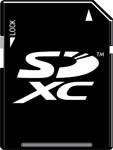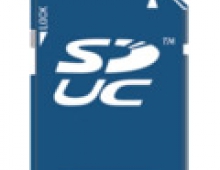
New SDXC Memory Cards Provide up to 2TB of Storage
The next-generation SDXC (eXte
 The SDXC specification, developed by the SD Association, leapfrogs memory card interface speeds while retaining the SD interface. Specifications for the open standard will be released in the first quarter of 2009. SDHC, Embedded SD and SDIO specifications will also benefit from the new SD interface speeds.
The SDXC specification, developed by the SD Association, leapfrogs memory card interface speeds while retaining the SD interface. Specifications for the open standard will be released in the first quarter of 2009. SDHC, Embedded SD and SDIO specifications will also benefit from the new SD interface speeds.
"SDXC combines a higher capacity roadmap with faster transfer speeds as a means to exploit NAND flash memory technology as a compelling choice for portable memory storage and interoperability," said Joseph Unsworth, research director, NAND Flash Semiconductors, at Gartner. "With industry support, SDXC presents manufacturers with the opportunity to kindle consumer demand for more advanced handset features and functionality in consumer electronics behind the ubiquitous SD interface."
SDXC allows users to enjoy more from their mobile phones. Larger capacity and faster transfer speeds allow for expanded entertainment and data storage. A 2TB SDXC memory card can store 100 HD movies, 60 hours of HD recording or 17,000 fine-grade photos.
"With SDXC, consumers can quickly download higher quality content to their phones, including games, video and music ? giving consumers a richer media and content experience," said James Taylor, president of the SD Association. "The SD interface already has proven itself valuable in mobile phones. Now, SDXC memory card capabilities will spur further handset sophistication and boost consumer content demand."
SDXC is also the first memory card specification to provide 2TB storage without hindering the high-speed performance necessary for high-end photography. It will provide maximum speeds even when the SDXC specification achieves its maximum 2TB storage capacity.
"SDXC is a large-capacity card that can store more than 4,000 RAW images, which is the uncompressed mode professionals use, and 17,000 of the fine-mode most consumers use. That capacity, combined with the exFAT file system, increases movie recording time and reduces starting time to improve photo-capturing opportunities," said Shigeto Kanda, general manager at Canon. "Improvements in interface speed allow further increases in continuous shooting speed and higher resolution movie recordings. As a memory card well suited to small-sized user-friendly digital cameras, the SDXC specification will help consumers realize the full potential of our cameras."
The SDXC specification uses Microsoft?s exFAT file system to support its large capacity and interoperability in a broad range of PCs, consumer electronics and mobile phones. The exFAT system was designed for increased compatibility with flash media, from portability of data to interoperability with multiple platforms and devices on removable media.
 The SDXC specification, developed by the SD Association, leapfrogs memory card interface speeds while retaining the SD interface. Specifications for the open standard will be released in the first quarter of 2009. SDHC, Embedded SD and SDIO specifications will also benefit from the new SD interface speeds.
The SDXC specification, developed by the SD Association, leapfrogs memory card interface speeds while retaining the SD interface. Specifications for the open standard will be released in the first quarter of 2009. SDHC, Embedded SD and SDIO specifications will also benefit from the new SD interface speeds.
"SDXC combines a higher capacity roadmap with faster transfer speeds as a means to exploit NAND flash memory technology as a compelling choice for portable memory storage and interoperability," said Joseph Unsworth, research director, NAND Flash Semiconductors, at Gartner. "With industry support, SDXC presents manufacturers with the opportunity to kindle consumer demand for more advanced handset features and functionality in consumer electronics behind the ubiquitous SD interface."
SDXC allows users to enjoy more from their mobile phones. Larger capacity and faster transfer speeds allow for expanded entertainment and data storage. A 2TB SDXC memory card can store 100 HD movies, 60 hours of HD recording or 17,000 fine-grade photos.
"With SDXC, consumers can quickly download higher quality content to their phones, including games, video and music ? giving consumers a richer media and content experience," said James Taylor, president of the SD Association. "The SD interface already has proven itself valuable in mobile phones. Now, SDXC memory card capabilities will spur further handset sophistication and boost consumer content demand."
SDXC is also the first memory card specification to provide 2TB storage without hindering the high-speed performance necessary for high-end photography. It will provide maximum speeds even when the SDXC specification achieves its maximum 2TB storage capacity.
"SDXC is a large-capacity card that can store more than 4,000 RAW images, which is the uncompressed mode professionals use, and 17,000 of the fine-mode most consumers use. That capacity, combined with the exFAT file system, increases movie recording time and reduces starting time to improve photo-capturing opportunities," said Shigeto Kanda, general manager at Canon. "Improvements in interface speed allow further increases in continuous shooting speed and higher resolution movie recordings. As a memory card well suited to small-sized user-friendly digital cameras, the SDXC specification will help consumers realize the full potential of our cameras."
The SDXC specification uses Microsoft?s exFAT file system to support its large capacity and interoperability in a broad range of PCs, consumer electronics and mobile phones. The exFAT system was designed for increased compatibility with flash media, from portability of data to interoperability with multiple platforms and devices on removable media.



















